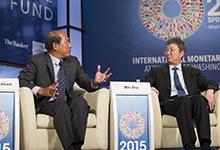
Typical street scene in Santa Ana, El Salvador. (Photo: iStock)
IMF Survey : Financing For Development: The Way Forward
April 18, 2015
- Sustainable Development Goals to replace Millennium Development Goals this year
- Broader scope, but comes with heftier price tag
- Private capital will be required to meet financial demands
As the United Nations prepares to adopt its new Sustainable Development Goals (SDGs) later this year, IMF Deputy Managing Director Min Zhu, at the Spring Meetings debate, addressed concerns that the goals may be too ambitious.

IMF Deputy Managing Director Min Zhu, and Florencio Barsana Abad discussing Sustainable Development Goals at IMF Spring Meetings (photo: IMF)
SPRING MEETINGS PROGRAM OF SEMINARS
“I agree–it’s not easy to remember 169 targets and 17 goals. But the Millennium Development Goals (MDGs) were very focused on reducing poverty, whereas the SDGs go way beyond that, covering much broader issues related to sustainable growth and prosperity.”
Zhu’s remarks came as part of a panel discussion on how the international community might finance the new goals.
New goals: broader scope, heftier price tag
United Nations Under-Secretary General for Economic and Social Affairs Wu Hongbo, said the new development agenda will cover all member states—rich and poor, for the next 15 years. But Wu admitted the broader scope comes with a heftier price tag, far exceeding the cost of the MDGs.
“In addition to eradicating poverty, this agenda will cover economic, social and environmental issues, so huge amounts of financial resources will be required for its implementation.”
The World Bank’s Chief Financial Officer, Betrand Badré, said the cost of implementing the SDGs would likely be in the trillions, whereas the current Official Development Assistance program runs in the billions of dollars. But Badré also pointed out that there may be an opportunity in the private sector, where there are trillions of dollars looking for yield.
Jeffrey Sachs, director of the Earth Institute, said whatever financing plan they come up with will have to include the private sector, because “governments in the west are broke.”
But, he added, it’s not so much the money he’s concerned about at this point.
“We need new clear initiatives so the low-income country can achieve the SDG on Health or the SDG on Education, or on Hunger. We don’t even have that right now. We don’t have specific initiatives on the table that are aligned with the sustainable development goals.”
Need for deliverables
Florencio Barsana Abad, Budget and Management Secretary for the Philippine government, said the breadth of the SDGs as described could include “everything under the sun,” and agreed with Sachs that clear initiatives needed to be established well ahead of the Addis Ababa International Conference on Financing for Development taking place in July.
“We do need some deliverables by July. We can’t just go to this meeting and expect everyone’s going to be happy with a few platitudes. We actually have to have some finance that backs these bold goals.”
While Sachs and other participants said they’d like to see the number of goals and targets reduced, Wu Hongbo said it was the UN’s 193 member states that chose the targets as a means to tackle unsustainable socio-economic problems like inequality, and environmental abuses.
“What we’re trying to do is, instead of working in Silos on specific areas, we bring the three aspects together. Everyone on the planet needs to have a target, governments in particular. We work for the whole world, and for our future generation.”
Finance to back goals
Min Zhu suggested the financing challenges could be met by supplementing the current donor commitments with broader resource mobilization strategies, like subsidy reforms and carbon taxing, which together could generate two trillion dollars. He added, maintaining strong growth would underpin these initiatives.
“So there are a lot of resources on the table we could tap into, but we also have to deepen the financial sector and develop the capital market so we can tap into private capital as well, which is much bigger pools.”
Jeff Sachs agreed that private capital could do a lot towards financing the SDGs, and suggested they reach out to the world’s wealthiest, who have the means to co-finance the venture.
“We have 1,826 Billionaires that have a net worth of $7.1 trillion. Trillion! Since I’m at a University I think in terms of endowments. If they were to endow the SDGs with their net worth, a 5 percent payout ratio would be $355 billion a year. That’s almost three times what governments give in all aid!”
But Ethiopian Finance Minister, Sufian Ahmed Beker, was quick to weigh in, noting until the Gates Foundation comes knocking, what would really help is if corporations paid more taxes. Beker said increasing the tax rate from 15 to 20 percent would make a huge difference in their domestic revenue mobilization capacity.
All 17 Sustainable Development Goals and their 169 targets are expected to be adopted by the United Nations General Assembly in September 2015.


